The document defines key terms related to science, technology, engineering, research and development, innovation, and technology management. It then provides details on technology, including its characteristics, components, differences between science and technology, and technology forecasting methods. The document also discusses technology acquisition, absorption, strategic alliances, and international strategies for technology development.
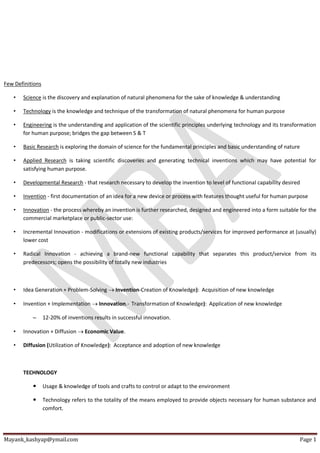









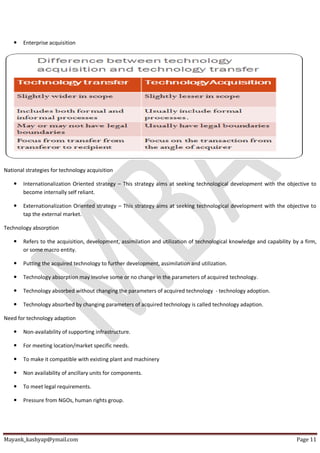




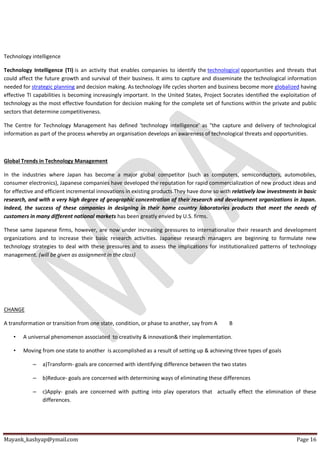
![Mayank_kashyap@ymail.com Page 17
• Change problem focuses on three issues-
– How, What & Why
– ‘How’ aims at means to be adopted in transformation,i.e. systems & operations
– ‘What’ aims at ends to be attained depending upon what lies in stocks, management or support functions & what
is to be achieved
– ‘Why’ to get ultimate purpose of change as ends & means are relative & not absolute notions-mission& vision,
chain & network are assessed.
Characteristics & Nature of change
• Brings difference in products, culture & work practices
• On going & inevitable because innovate or abdicate, change or perish
• Offers opportunities & challenges
• Internal as well as external
• All pervasive in the organization
• Change at different levels & may be first order(incremental) or second order(radical)
• Planned or unplanned, slow or fast
• Abandons obsolete practices, negative values & increases motivation.
Change management
is an approach to shifting/transitioning individuals, teams, and - in general - organizations from a current state to a desired future
state. It is an organizational process aimed at helping change stakeholders to accept and embrace changes in their business
environment or individuals in their personal lives.[citation needed] In some project management contexts, change management
refers to a project management process wherein changes to a project are formally introduced and approved.[1]
Change management uses basic structures and tools to control any organizational change effort. The goal is to maximize benefits
and minimize the change impacts on workers and avoid distractions
Organizational Change
• An alteration of an organization’s environment, structure, culture, technology, or people
– A constant force
– An organizational reality
– An opportunity or a threat](https://image.slidesharecdn.com/mticunit-1-150124115901-conversion-gate01/85/Management-Technology-Innovation-Change-17-320.jpg)
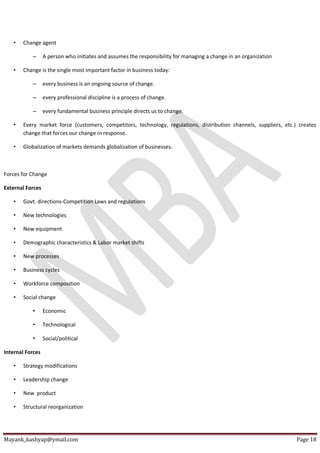
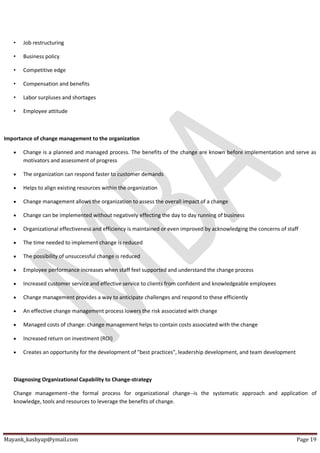


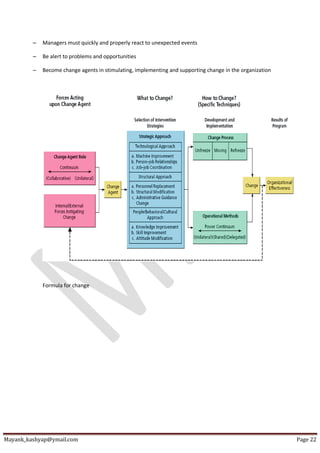



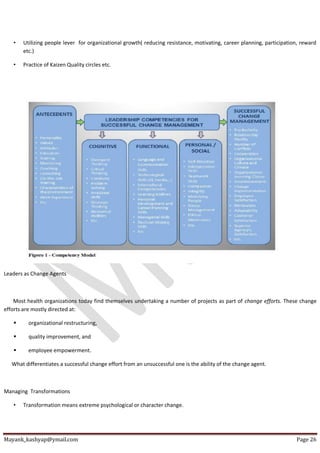






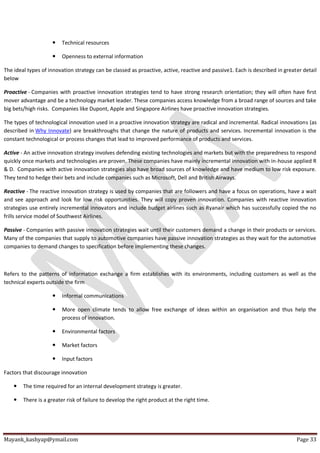


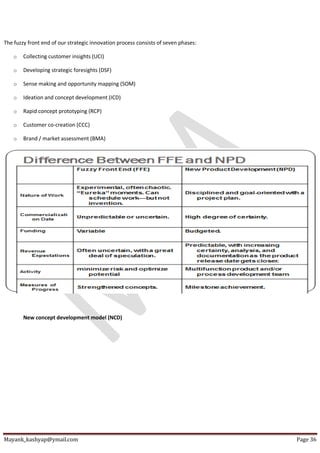

![Mayank_kashyap@ymail.com Page 38
• Reduced environmental damage
• Replacement of products/services
• Reduced energy consumption
• Conformance to regulations
Failure of innovation
• Poor Leadership
• Poor Organisation
• Poor Communication
• Poor Empowerment
• Poor Knowledge Management
• Poor goal definition
• Poor alignment of actions to goals
• Poor participation in teams
• Poor monitoring of results
• Poor communication and access to information
Concurrent Engineering
Concurrent engineering is a work methodology based on the parallelization of tasks (i.e. performing tasks concurrently). It refers
to an approach used in product development in which functions of design engineering, manufacturing engineering and other
functions are integrated to reduce the elapsed time required to bring a new product to the market.
Concurrent engineering replaces the more traditional sequential design flow, or ‘Waterfall Model’.[5][6]
In Concurrent engineering
an iterative or integrated development method is used instead[7]
The difference between these two methods is that the
‘Waterfall’ method moves in a linear fashion by starting with user requirements and sequentially moving forward to design,
implementation and additional steps until you have a finished product. In this design system, a design team would not look
backwards or forwards from the step it is on to fix possible problems. In the case that something does go wrong, the design
usually must be scrapped or heavily altered. On the other hand, the iterative design process is more cyclic in that, all aspects of
the life cycle of the product are taken into account, allowing for a more evolutionary approach to design.[8]
The difference
between the two design processes can be seen graphically in Figure 1.](https://image.slidesharecdn.com/mticunit-1-150124115901-conversion-gate01/85/Management-Technology-Innovation-Change-38-320.jpg)
![Mayank_kashyap@ymail.com Page 39
Traditional “Waterfall” or Sequential Development Method vs. Iterative Development Method in concurrent engineering
A significant part of the concurrent design method is that the individual engineer is given much more say in the overall
design process due to the collaborative nature of concurrent engineering. Giving the designer ownership is claimed to improve
the productivity of the employee and quality of the product that is being produced, based on the assumption that people who are
given a sense of gratification and ownership over their work tend to work harder and design a more robust product, as opposed
to an employee that is assigned a task with little say in the general process.[4]
Concurrent engineering elements
Cross-functional teams
Include members from various disciplines involved in the process, including manufacturing, hardware and software
design, marketing, and so forth
Concurrent product realization
Process activities are at the heart of concurrent engineering. Doing several things at once, such as designing various
subsystems simultaneously, is critical to reducing design time.
Incremental information sharing
It helps minimize the chance that concurrent product realization will lead to surprises. As soon as new information
becomes available, it is shared and integrated into the design. Cross functional teams are important to the effective sharing of
information in a timely fashion.
Integrated project management
It ensures that someone is responsible for the entire project, and that responsibility is not abdicated once one aspect of
the work is done.
Disadvantages of concurrent design](https://image.slidesharecdn.com/mticunit-1-150124115901-conversion-gate01/85/Management-Technology-Innovation-Change-39-320.jpg)
![Mayank_kashyap@ymail.com Page 40
Concurrent design creates its own issues, such as the implementation of early design reviews, the dependency on
efficient communication between engineers and teams, software compatibility, and opening up the design process.[9]
A
concurrent design process usually requires that computer models (computer aided design, finite element analysis) are exchanged
efficiently, something that can be difficult in practice. If such issues are not addressed properly, concurrent design may not work
effictively.[10]
Service providers exist that specialize in this field. Not only training people how to perform Concurrent Design effectively,
but also providing the tools to enhance the communication between the team members. Organizations such as *ESA's Concurrent
Design Facility make use of Concurrent Design to perform feasibility studies for future missions.
Process innovation
A process innovation is the implementation of a new or significantly improved production or delivery method. This includes
significant changes in techniques, equipment and/or software.”
“… The implementation of a new or significantly improved production… method” involves the development of a new way
to produce a product using a newly developed machine, a new method such as the Pilkington Floating Glass method or the blast
furnace, or the use of new software like 3D modelling software as part of the process or for developing new products.
Process innovation helps in
reducing costs per unit of installed capacity
Improving quality
Enhancing volume
Spreading fixed cost over large number of units
Bringing standardization
Reducing lead time
Increasing stock turnover
Increasing machine utilization
Reducing work in progress on average
Techniques of Process Innovation
Material resource planning
Just in time
Flexible manufacturing systems](https://image.slidesharecdn.com/mticunit-1-150124115901-conversion-gate01/85/Management-Technology-Innovation-Change-40-320.jpg)
![Mayank_kashyap@ymail.com Page 41
Computer assisted design, manufacture & engineering
Total quality management
Business process re-engineering
Outsourcing
Product innovation-
it may include the component knowledge( degree to which a specific tech. departs from earlier one) & component configuration
(degree to which configuration departs from earlier one). product innovation is the creation and subsequent introduction of
a good or service that is either new, or improved on previous goods or services. This is broader than the normally accepted
definition of innovation to include invention of new products which, in this context, are still considered innovative.
Product innovation is defined as:
the development of new products, changes in design of established products, or use of new materials or components in
the manufacture of established products[1]
Thus product innovation can be divided into two categories of innovation:
development of new products, and improvement of existing products.](https://image.slidesharecdn.com/mticunit-1-150124115901-conversion-gate01/85/Management-Technology-Innovation-Change-41-320.jpg)

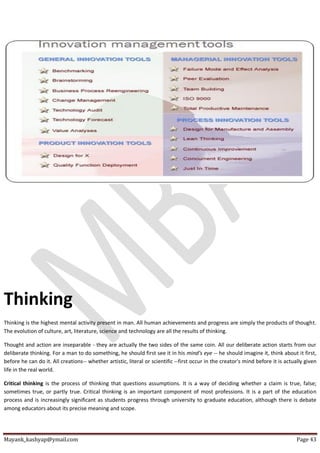


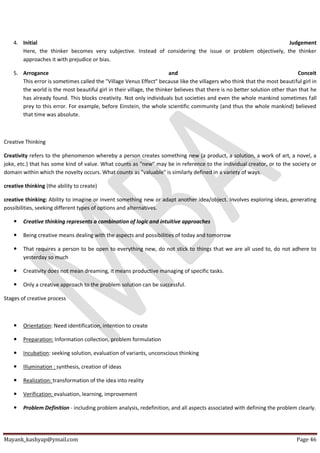

![Mayank_kashyap@ymail.com Page 48
Problem solving is a mental process which is part of the larger problem process that includes problem finding and problem
shaping. Considered the most complex of all intellectual functions, problem solving has been defined as higher-order cognitive
process that requires the modulation and control of more routine or fundamental skills.[1]
Problem solving occurs when an
organism or an artificial intelligence system needs to move from a given state to a desired goal state.
CREATIVE PROBLEM SOLVING PROCESS
STEP 1. State what appears to be the problem.
The real problem may not surface until facts have been gathered and analyzed. Therefore, start with what you assume to
be the problem, that can later be confirmed or corrected.
STEP 2. Gather facts, feelings and opinions
STEP 3. Restate the problem.
The real facts help make this possible, and provide supporting data.
The actual problem may, or may not be the same as stated in Step 1.
STEP 4. Identify alternative solutions.
Generate ideas. Do not eliminate any possible solutions until several have been discussed.
STEP 5. Evaluate alternatives
STEP 6. Implement the decision
STEP 7. Evaluate the results.
• Test the solution against the desired results.
• Make revisions if necessary.](https://image.slidesharecdn.com/mticunit-1-150124115901-conversion-gate01/85/Management-Technology-Innovation-Change-48-320.jpg)


